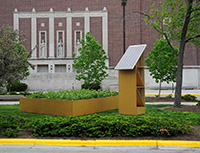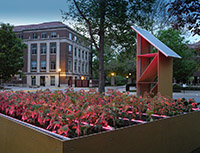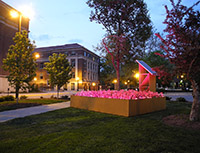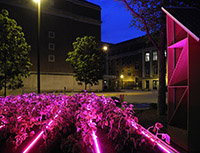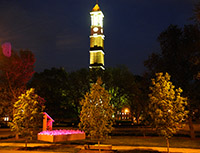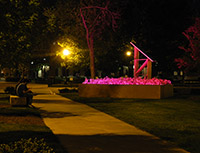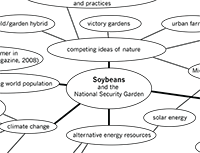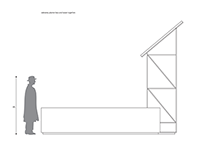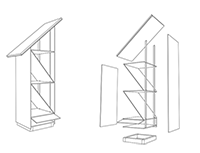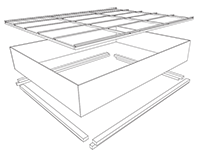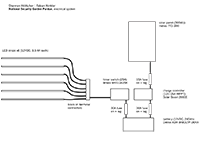In the Spring semester 2013, McMullen_Winkler installed the National
Security Garden, a public artwork featuring a planter box filled with
soybeans, embedded LED grow lights and a solar tower on the West
Lafayette, IN campus of Purdue University, an institution well-known for its
agriculture and technology research programs. It is the project's goal to create
a new image of soybean plants that stimulates the cultural imaginary and
critical thought, and to develop new visual metaphors for the intricate
relationships between nature and technology.
Description
In the Spring 2013 semester McMullen_Winkler were invited by the
Associate Dean of Purdue's Honors College, Dr. Emily Allen to create the
National Security Garden public artwork at Purdue University - as the
experiential learning component of the Honors freshman seminar on food
security. Similar to the National Security Garden in Singen Htwl., the
conceptual starting point for this public artwork were the many
connections the soybean plant makes to issues of food security, energy
independence, agricultural practices, politics - and eventually to
issues of national security. This time however, the work was placed in a
regional context where soybean research and mono-cultural practices are
central to agriculture: in the Midwest of the United States. Having a
deliberately provocative title, the work suggests that there are
connections between farming methods, energy consumption, climate change
and food security, which in turn can be related to broader issues of
national security. In fact, the issues the work is dealing with harbor
the potential for strong political divisions and nationalistic thinking.
Nevertheless the artists do not try to advance any particular policy or
political agenda. In contrast, McMullen_Winkler are promoting critical
inquiry and discussion from multiple disciplinary perspectives using
artistic strategies and embedding the installation in explicit
discursive and visual sites like: a symposium, a gallery exhibition and
on-site discussion opportunities with the artists and their
collaborators (Honors students). This strategy made the work an ideal
educational component in Purdue's Honors College: Honors freshman
students participated in all aspects of the production of the artwork
and afterward were actively involved in discussions with the campus/West
Lafayette community about issues of food security, agricultural
practices, biotechnology, politics, etc...
The artwork became an artifact
(a conversation piece) for the exchange of ideas, critical discussions
and public discourse that allowed the students to enter from their own
disciplinary perspective. Similar to the public presentations
accompanying the National Security Garden installation in Germany,
McMullen_Winkler together with the Honors students organized a symposium
at Purdue University on April 22, 2013 that further contextualized the
issues embedded in the artwork. Presenters in this symposium included
McMullen_Winkler, Dr. Patricia Boling (Purdue University, Dept. of
Political Science) and Col. Mark Mykleby (New America Foundation).
Furthermore, the public artwork was contextualized by an exhibition of
related works, a project documentation, reference library and overhead
slides prepared by the students in the Robert L. Ringel Gallery at
Purdue (April 26 - July 18, 2013). Together with chef Kimberly Lulay
(from Purdue's hospitality and tourism management program) a group of
honors students prepared appetizers made from fresh/unprocessed soy
ingredients for the exhibition's opening reception. The National
Security Garden was conceived as a temporary public artwork, it was
installed between Purdue's Bell Tower and the university administrative
offices in Hovde Hall from April 1 - July 21, 2013.

